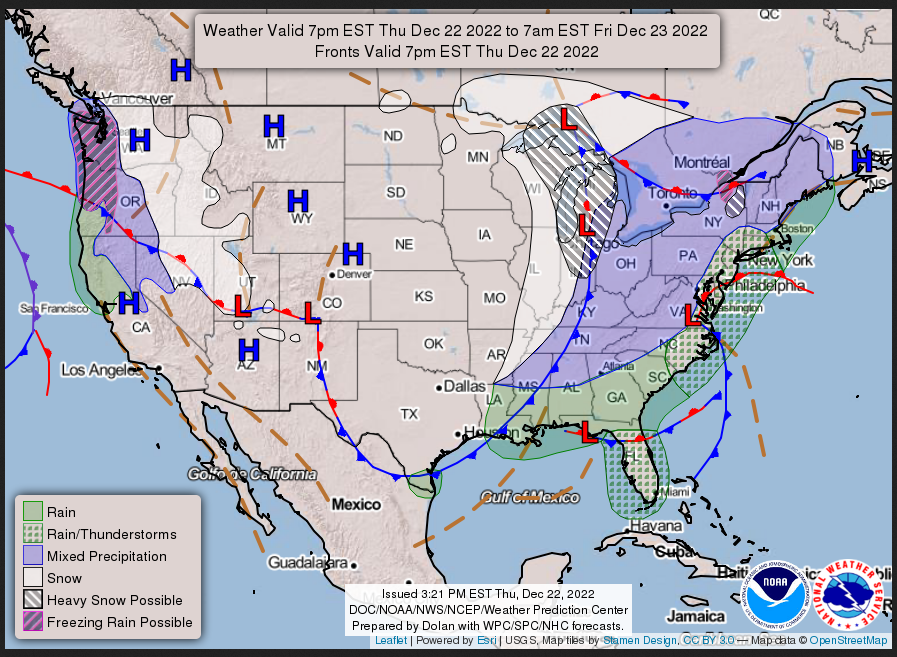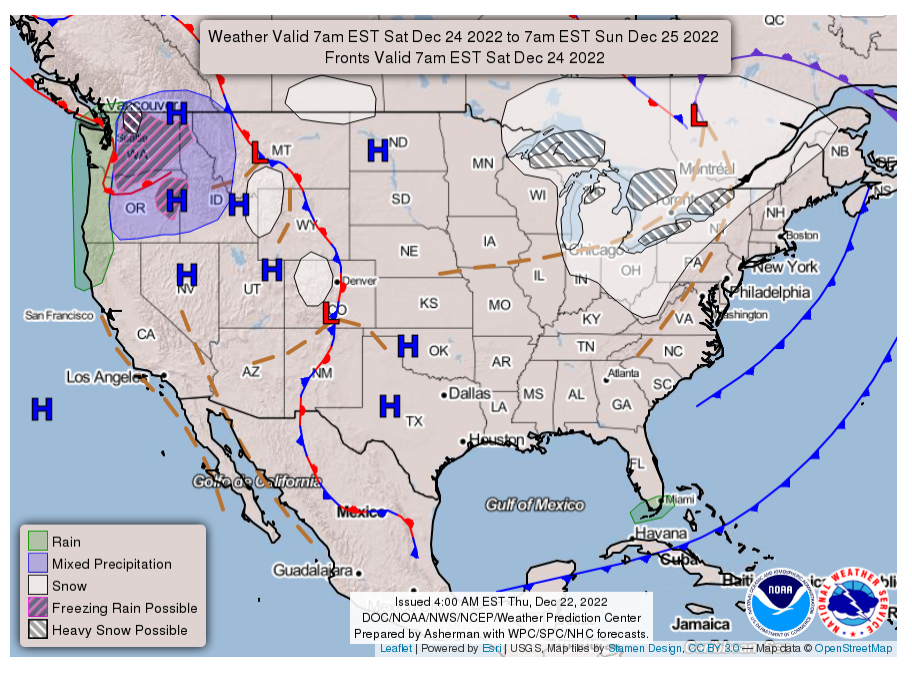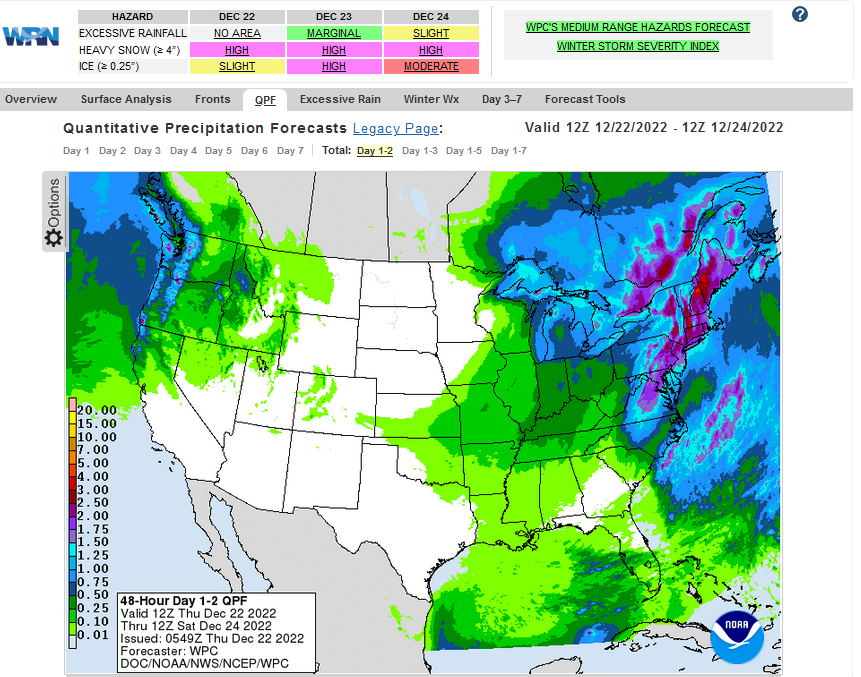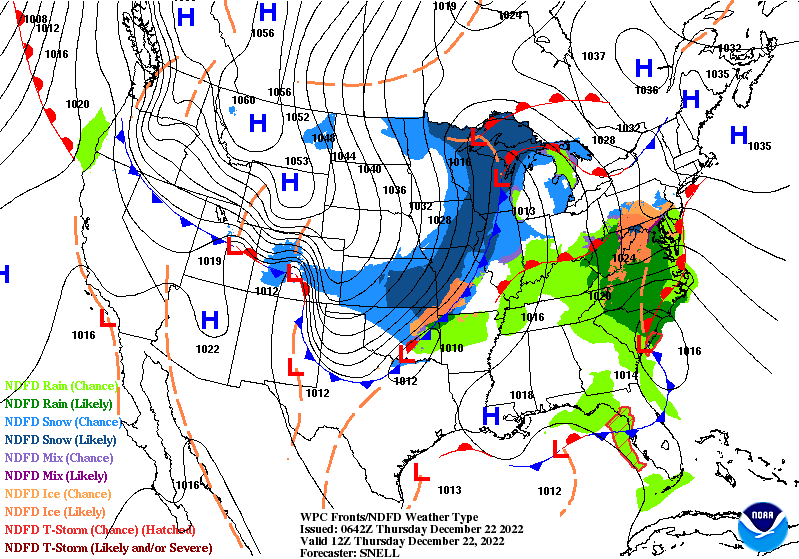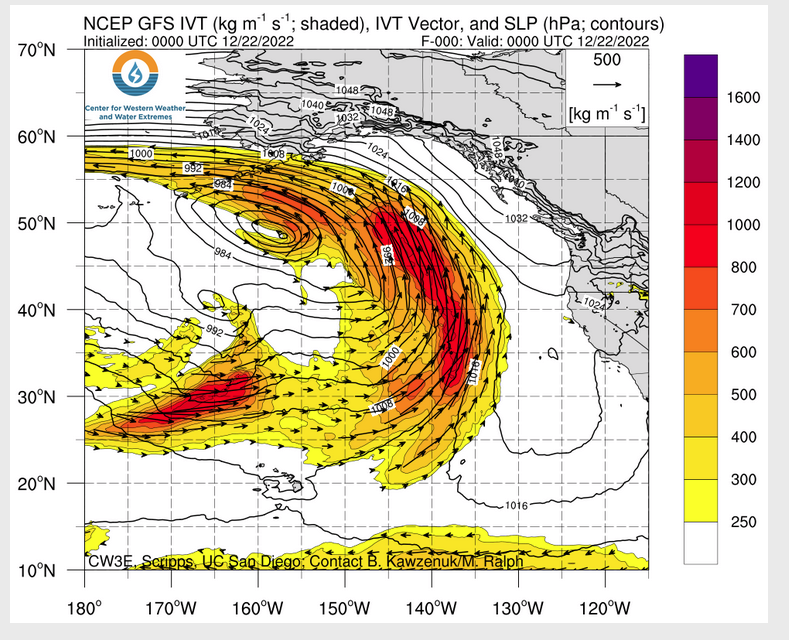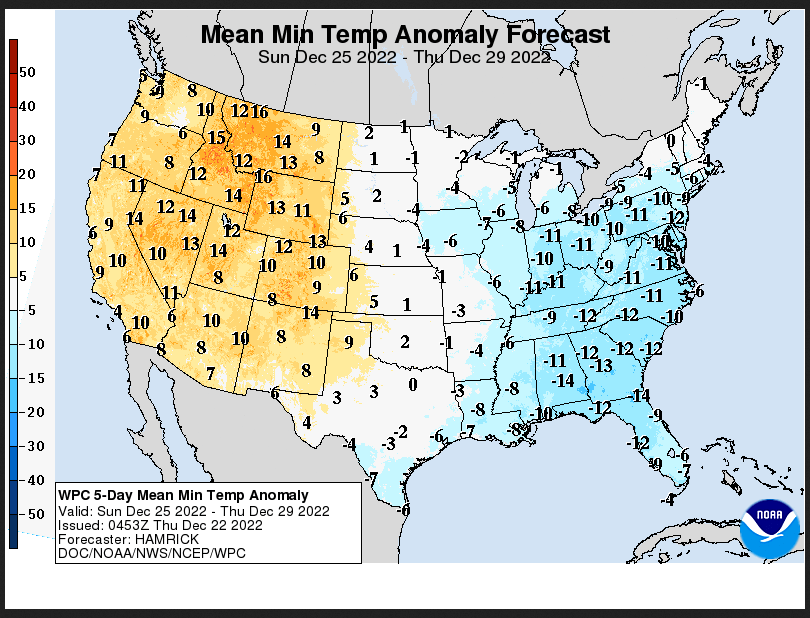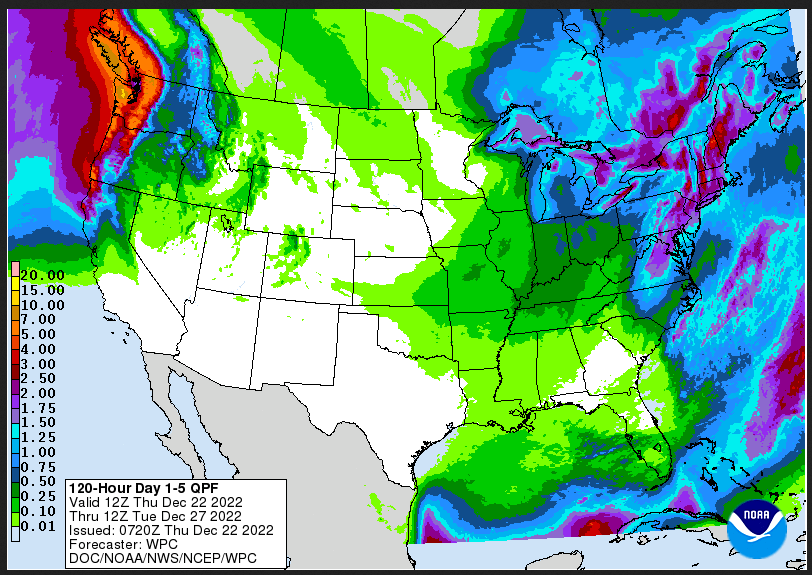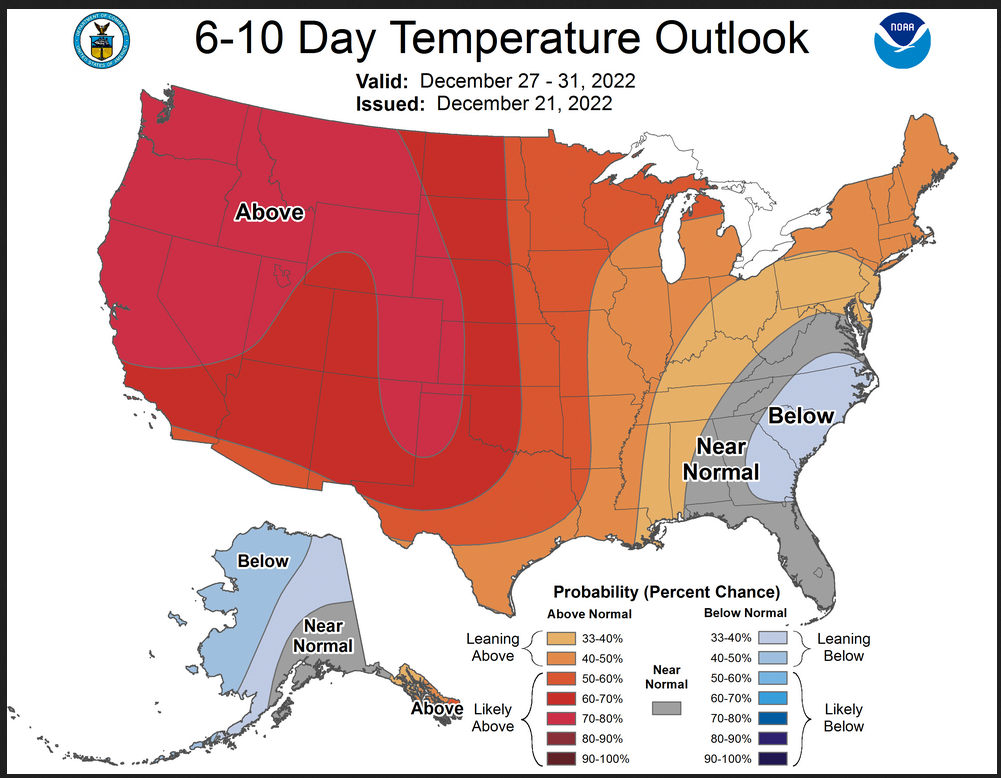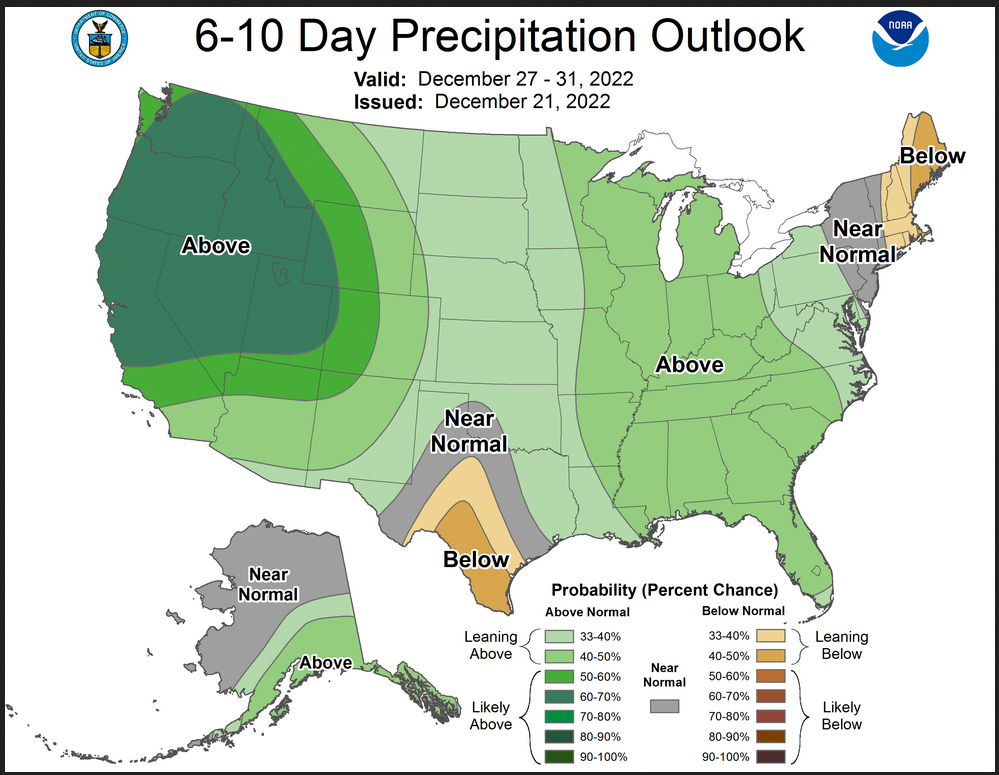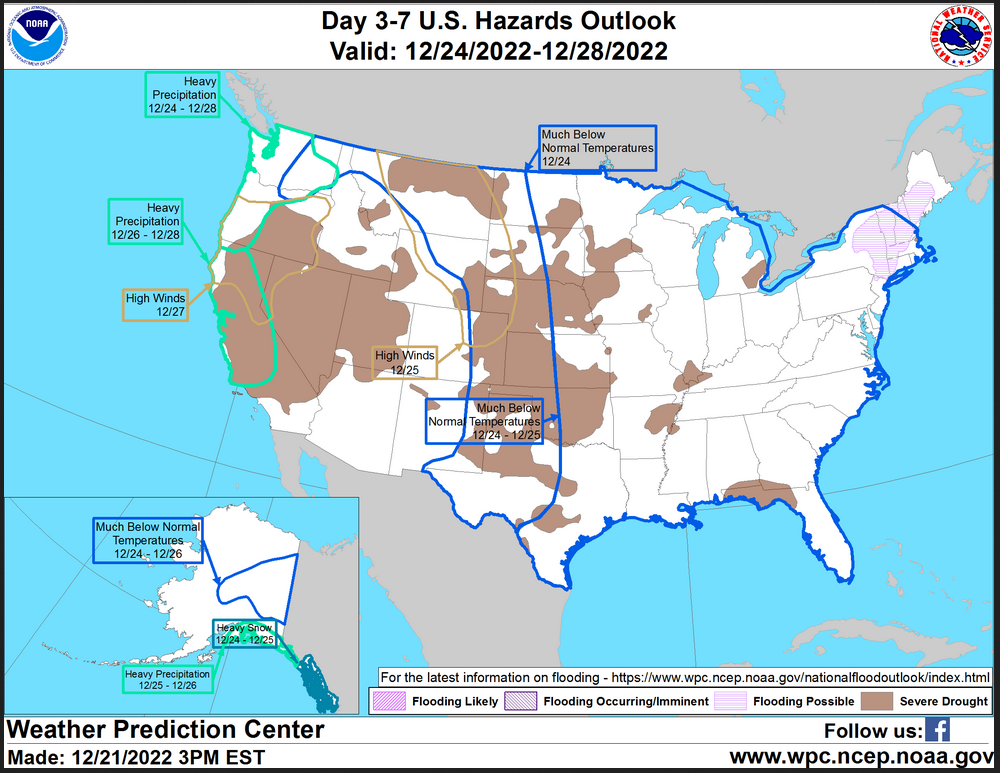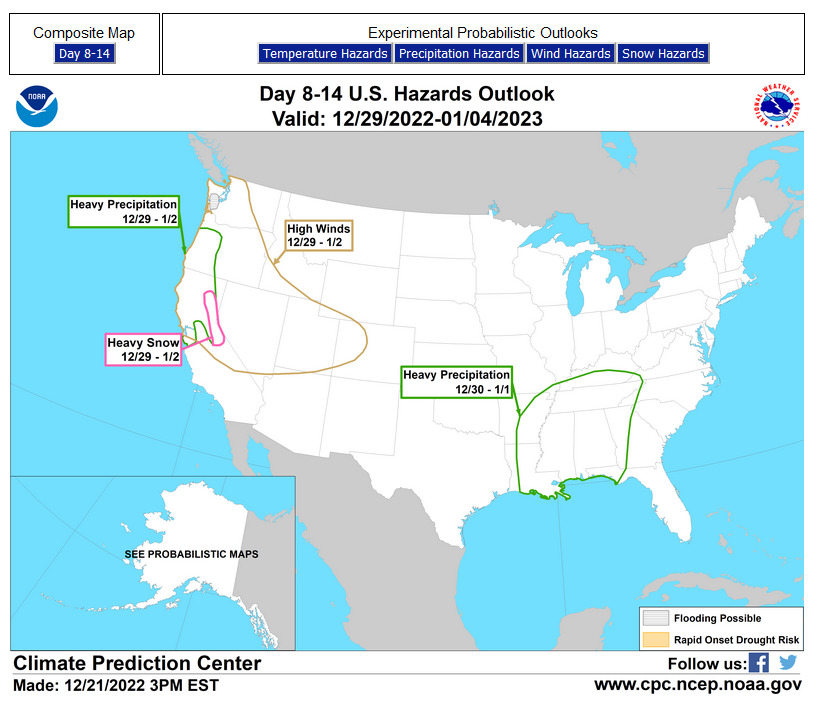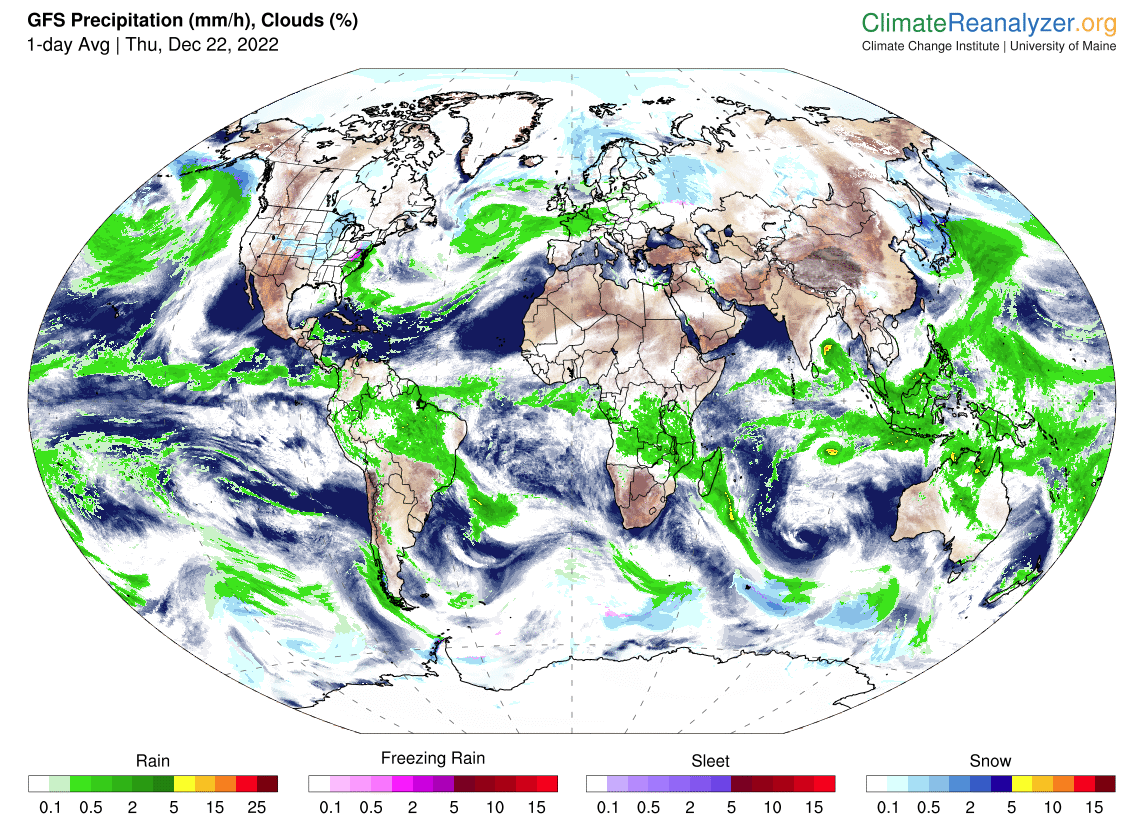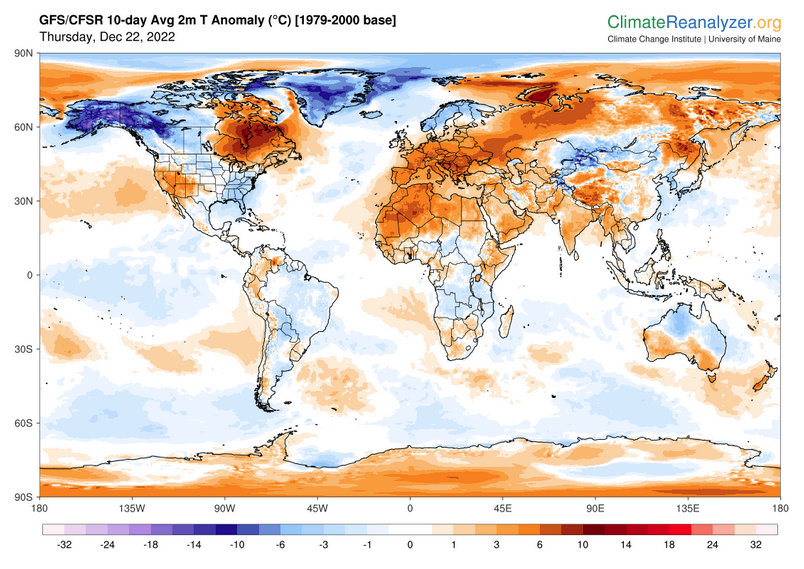Updated at 4:15 p.m. Thursday, December 22, 2022
Here is what we are paying attention to the next 48 hours from Thursday Afternoon’s NWS Forecast. This is a combination of a U.S. plus World Weather Article. We start with the U.S. Information.
Short Range Forecast Discussion
NWS Weather Prediction Center College Park MD
303 PM EST Thu Dec 22 2022
Valid 00Z Fri Dec 23 2022 - 00Z Sun Dec 25 2022
...Historic winter storm to produce widespread disruptions to large
portions of the nation heading into the holiday weekend...
...Nearly 280 million people under some form of winter weather warnings or
advisories across the U.S....
...Powerful Arctic front to sweep into the eastern third of the nation
Thursday night into Friday, while temperatures will begin to rebound
across the Northern Rockies and High Plains this weekend...
...Heavy Snows to blanket the Great Lakes region into northern NY State
and northern New England...
...Significant freezing rain possible across the Pacific Northwest...
Continuation of the NWS Short Range Forecast (It is updated by NWS twice a day and these updates can be found here. We post at least one of those updates daily, sometimes both.
A tremendously impactful winter storm will continue to affect large portions of the nation late this week and going into the holiday weekend. Winter weather hazards will stretch from border to border across the central and eastern U.S. and from coast to coast from the east coast to the Pacific Northwest. The National Weather Service's Watch Warning graphic ( https://www.weather.gov/) depicts one of the greatest extents of winter weather warnings and advisories ever. As of Thursday afternoon, nearly 280 million people in the U.S. are under some form of winter weather warning or advisory. This includes nearly 150 million for wind chill warnings or advisories, 114 million for blizzard warning, 56 million for winter storm warnings and 500 thousand for ice storm warnings. This storm will likely will have increasingly widespread impacts to travel going into the busy holiday travel time late this week, along with the potential for power outages from the expected high winds, heavy snows, significant icing and overall increased power consumption in places. The powerful arctic front that brought huge temperature drops across the Plains over the past 24 hours will be sweeping eastward across the eastern third of the nation Thursday night into Friday. Many locations from portions of the Northern Rockies into the Central to Southern High Plains saw temperatures drops greater than 50 degrees in the wake of the passage of the arctic front, including 67 degrees colder at Cheyenne, Wyoming and 72 degrees colder at Denver, Colorado. While the temperature drops behind the arctic front are not expected to be as great from the MS Valley into the eastern U.S., it will still feel abruptly colder with many locations 30-40 degrees colder in the wake of the arctic front. Widespread record low maximum temperature are possible Friday from the Lower Mississippi Valley, northeastward into the Tennessee and Ohio Valleys and stretching across large sections of the east from the Southeast, through the Southern to Central Appalachians and into the Mid-Atlantic on Friday. In addition to the very cold temperatures, high winds in the wake of the front will produce dangerous wind chill readings across nearly all of the central to eastern U.S. In addition to the very cold temperatures, a developing low pressure system along the arctic front over the Mid West/Great Lakes region will produce widespread heavy snows from portions of the Mid West into the Great Lakes on Friday. This will be followed by active lake effect snow showers downwind of all of the Great Lakes on Saturday as the very cold arctic air streams across the Great Lakes. Blizzard warnings and Winter Storm warnings are currently in effect from the Great Lakes, Mid West, Middle to Upper Mississippi Valley and into the Northern Plains. Relief is in site from the very cold temperatures for areas from the Northern Rockies into the High Plains by this weekend as temperatures will rebound tremendously from current readings. In many locations, temperatures will be 40 to 60 degrees warmer by this weekend as the core of cold air will be across the east, while the above average temperatures currently across the Southwest spread farther to the north and east and push across the Rockies and into the High Plains. Not to be left out of the active winter weather across the central to eastern U.S., there is the potential for significant icing across the Pacific Northwest Thursday night into Friday as moisture from the Pacific falls into low level arctic air currently entrenched across this area. This low level arctic air is the western extent of the arctic airmass centered across the central portion of the nation. It does appear that this low level arctic air over the Pacific Northwest will warm sufficiently by late Friday night along coastal sections to diminish the freezing rain threat. The freezing rain threat will continue, however, inland through the Columbia River Valley and across areas east of the Cascades through much of Saturday.
Day 1 and Day 2 Maps can be found by clicking Here for Day 1 and Here for Day 2. This Link works also.
THURSDAY EVENING THROUGH OVERNIGHT
FRIDAY
SATURDAY
Current Two-day forecast of heavy precipitation (Updates can be found HERE)
Here is a 60-hour animated forecast map that shows how the short-term forecast is expected to play out
If it needs to be updated click here.
ATMOSPHERIC RIVERS
–
| Maybe I should show this later as it’s main value is telling us what is going to arrive on the West Coast. |
Click HERE to update. Here is some useful information about Atmospheric Rivers.
Days 1 Through 5 and 6 – 10 (I update these graphics every two days – but the reader can get an update if they want but the situation usually does not change that quickly)
| Days 1 – 5 (3 – 7 for Temperature) | Days 6 – 10 |
| https://www.wpc.ncep.noaa.gov/medr/medr_mean.shtml | https://www.cpc.ncep. noaa.gov/products/predictions/610day/ |
| These graphics update and can be clicked on to enlarge. You can see where the weather will be. An alternate website is https://www.wpc.ncep.noaa.gov/qpf/day1-7.shtml | |
–
Days 6 – 10 Outlook
An outlook differs from a forecast based on how NOAA uses these terms in that an “outlook” presents information from deviation from normal and the likelihood of these deviations.
HAZARDS OUTLOOKS (I update these graphics every two days – but the reader can get an update if they want but the situation usually does not change that quickly)
Click here for the latest complete Day 3 -7 Hazards forecast which updates only on weekdays. Once a week probably Monday or Tuesday I will update the images. I provided the link for readers to get daily updates on weekdays. Use your own judgment to decide if you need to update these images.
Worldwide Weather (The U.S. is part of the World so the U.S. forecast is included in these maps)
Below maps are the short-term forecast for precipitation and 10-day forecast for temperature and precipitation. I update the Day 1 Forecast daily and the ten-day forecasts every two days. A ten-day forecast is not likely to change much in 24 hours. But if you are looking at an out-of-date version of this article the current forecast maps can be obtained HERE.
Worldwide Tropical Forecast
(This graphic updates on Tuesdays) If it has not been updated, you can get the update by clicking here This is a new approach and covers weeks 2 and 3 not weeks 1 and 2. It has more information but I am having trouble getting used to it. As usual, it comes with a discussion which is below
Detailed Maps and Reports for the Western Atlantic and the Pacific Oceans
Below are four maps that summarize the situation for the Atlantic, Eastern, Central Pacific, and Western Pacific. Additional information can be accessed by clicking HERE
First the Atlantic
Click to view the forecast map and have access to additional information https://www.nhc .noaa.gov/gtwo.php?basin= atlc&fdays=5
Then Eastern Pacific
Click to view the forecast map and have access to additional information https://www.nhc.noaa.gov/gtwo.php?basin=epac&fdays=5
Then Central Pacific
Click to view the forecast map and have access to additional information https://www.nhc.noaa.gov/gtwo.php?basin=cpac&fdays=5
And the Western Pacific
Click to view the forecast map and have access to additional information https://www.metoc.navy.mil/jtwc/jtwc.html
Some Longer U.S. Intermediate-Term Outlooks
Links to “Outlook” maps and discussions for Two time periods. Days 8 – 14, and Weeks 3 and 4.
You have to click on the links because they do not update automatically and I do not want to have stale images in the article. But it is not difficult to click on a link and you get a large image plus a discussion. On Fridays in a separate article, we will show the images and provide a link in this article that article. But remember what you will see is the images as of Friday. But here you can get the current images simply by clicking on them. Then hit the return arrow at the upper left of your screen to return to the article. You will not find this information easily anywhere else.
| Days 8 – 14 | Weeks 3 and 4 |
| https://www.cpc.ncep.noaa.gov/products/predictions/814day/ | https://www.cpc.ncep.noaa.gov/products/predictions/WK34/ |
| These graphics update and can be clicked on to enlarge. You can see where the weather will e | |
–
Month to Date Information
Month to date Temperature can be found at https://hprcc.unl.edu/products/maps/acis/MonthTDeptUS.png
Month to date Precipitation can be found at https://hprcc.unl.edu/products/maps/acis/MonthPNormUS.png

